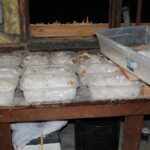As part of our Certified Industrial Hygiene (CIH) services, BioMax is frequently asked to develop site-specific cleanup procedures and methods to decontaminate methamphetamine (meth) contamination from surfaces. In fact, as BioMax’s Senior CIH, I have personally performed many hundreds of meth residue assessments since 1996 which have included single-family residences, rental properties, commercial properties, hotels/motels, houseboats, automobiles, and even bare/vacant land. Most of these assessments were performed as a result of a State regulatory mandate (following a meth lab bust) but also sometimes performed proactively as a result of information obtained regarding previous illegal activities and/or drug use at a site. It is widely recognized by law enforcement authorities that only a small fraction of drug lab manufacturing sites are discovered and most are discovered by property owners themselves, as a result of inspections of tenants, due diligence investigations within their properties, or through chance.
Once discovered, however, a sampling evaluation is part of what BioMax (as well as State regulators) generally call a Preliminary Site Assessment or PSA. This assessment includes a review of any available historical information followed by an inspection of the site to determine conditions of materials and the best locations for sampling and analysis. During this PSA action, a series of surface wipe samples will be collected from material and structural surfaces within the areas of concern using specific sampling media used to collect meth residues within a measured 10 x 10 square centimeter area. Samples are then recorded and transported to an accredited analytical laboratory (such as ALS analytical alsglobal.com) under Chain of Custody documentation wherein meth concentrations are measured and reported for each submitted sample.
Based on our review of these findings, we can then determine the best cleanup strategy for the affected surfaces (which I will discuss in detail later) based on the types of surfaces impacted and the specific levels identified. Cleanup methods can range from topical (surface) wipe cleaning methods using specified detergent-based solutions for low concentrations of surface contaminants, to total removal and disposal of materials (such as drywall, flooring, furnishings, etc.) when high concentrations of meth residues are identified.
But how is the meth contamination even formed in the first place??? …The answer lies in its creation and physical form as important factors to first consider. The general form of methamphetamine contamination (whether powder, liquid, aerosol, or surface residue) is generally determined by the physical state of the material through the way it was manufactured, handled or used. For example, the methamphetamine product itself is typically a crystalline solid or powder in its purest form. However, it is understood that the meth leaves a very sticky and oily residue on most surfaces when it is manufactured, handled, or used as the product becomes airborne as aerosols and vapors which readily deposit on nearby exposed surfaces. The residues left on these surfaces from common manufacturing methods (such as the red phosphorous and P2P synthesis methods) are generally derived from the aerosols of tiny airborne liquid droplets, which readily travel through the air and then collect and settle onto exposed surfaces through gravity.  Other ways meth residue contamination can be produced include the illegal purification methods (such as acetone conversion) where the raw methamphetamine solid is dissolved into an acetone base solvent liquid which is then re-crystallized in a concentrated form through evaporative techniques.
Other ways meth residue contamination can be produced include the illegal purification methods (such as acetone conversion) where the raw methamphetamine solid is dissolved into an acetone base solvent liquid which is then re-crystallized in a concentrated form through evaporative techniques.
This is not too far from the way we used to make “rock candy” as kids by dissolving common table sugar in water and then evaporated the solution onto strings or popsicle sticks to make beautiful and tasty crystallized sugar “rock” candy. Here is a picture of crystal meth discovered in the crawl space of a residence forming contamination “crystals” within the sub-flooring of this residence due to the spilling of liquids (containing meth) during the crystallization process onto the residence floor…
Although, it is commonly understood that manufacturing methods will produce the highest levels of residue methamphetamine contamination on surfaces, it has also been BioMax’s experience that sites can also have high levels of residues on surfaces even where no evidence of manufacturing existed.
Such sites include locations where significant meth contamination was found that had resulted from the distribution and storage activities associated with the product where it is frequently handled, weighed, and packaged on tabletops in illegal meth distribution houses and facilities. The physical form of this kind of contamination is usually a dust of fine white powder (or crystals), where particulates of meth dust accumulate on surfaces from sloppy handling and packaging techniques. In fact, the largest meth bust in US history (which occurred in San Jose, California) resulted in the capture of over 850 pounds of pure crystalline meth product in a relatively high-end apartment that was used entirely as a distribution center with no evidence of onsite manufacturing or conversion/purification. BioMax performed the sampling assessment of this site and determined (through analysis) that residue levels were highly elevated on interior surfaces at hundreds of times over the allowable regulatory limits.
 Another common form of meth contamination residue BioMax frequently encounters is derived from (what we call) “recreational use”… or better aptly termed “miss-use”!!! We know that methamphetamine can be injected, eaten, smoked and snorted, but the most popular way users take the drug is through free-basing the product in a “crack pipe” used inhale the heated vapors of meth directly into the users lungs. Projects where BioMax has performed sampling assessments in locations where recreational use was the only source of contamination also surprisingly resulted in significant surface residues. In fact such levels were measured at verified “use-only” sites at concentrations as high as 50 times greater than the allowable standard in California.
Another common form of meth contamination residue BioMax frequently encounters is derived from (what we call) “recreational use”… or better aptly termed “miss-use”!!! We know that methamphetamine can be injected, eaten, smoked and snorted, but the most popular way users take the drug is through free-basing the product in a “crack pipe” used inhale the heated vapors of meth directly into the users lungs. Projects where BioMax has performed sampling assessments in locations where recreational use was the only source of contamination also surprisingly resulted in significant surface residues. In fact such levels were measured at verified “use-only” sites at concentrations as high as 50 times greater than the allowable standard in California.
Therefore, the creation of methamphetamine contamination on surfaces has been proven to result from a number of sources and methods including: Manufacturing and synthesis of the product; Purification and conversion through acetone or solvent reduction; Storage, distribution, and physical handling of the product, and “recreational use” of the product through smoking, freebasing, ingesting, and snorting.
What we know about methamphetamine residues is that meth is a relatively “sticky” synthetic material that deposits from aerosols and vapors (from either manufacturing, storage, handling, and/or “recreational use”) directly onto interior surfaces and remain there for extended periods of time. We also know (see previous Blog) that once meth residues are deposited on various interior surfaces that they do not degrade to any significant degree and remain on these surfaces for extended periods of time… Therefore, it is important to have a very specific cleanup and decontamination strategy developed which addresses the physical state and form of meth residue contamination (as well as concentration) that is present at the site.
BioMax has extensive experience (over 20+ years) in methamphetamine assessment sampling and in the supervision and oversight of the mitigative cleanup process throughout California and the western United States. Mr. Polkabla has also consulted and worked with the California Department of Toxics Substances Control (DTSC), also know as Cal-EPA in the development and implementation of current methamphetamine assessment and cleanup regulations and standards within California.





